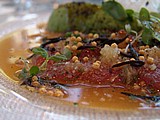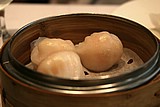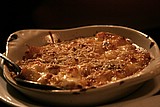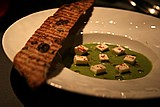Home |
Restaurants by City
|
Food Photography |
Archive | Philosophy |
![]()
Right now we are eating in Seattle, Washington.
|
Tuesday
2005
Permalink
|
Asiate, New York, New York, tasted on May 7, 2004 — On the one hand I am deeply wedded to the idea of chefs going deep and not flitting about from cuisine to cuisine, or borrowing elements from another cuisine they don't deeply understand to "dress up" their own food and make it "interesting". On the other hand, even though I know better, I often hope against hope that a fusion restaurant will have found a way to combine elements from two cuisines that is deep, original, and coherent. And for some reason, one of the favorite regions to borrow from is Asia. Maybe it's the contrast with typical European ingredients and flavors, and maybe the fad is over (though I don't think so) but so many chefs throw in a sprinkle of Asian dishes/ingredients that it almost goes unnoticed. And this brings us to Asiate which clearly states its fusion objectives up front - French and Japanese. It's location also makes a statement. A kissing cousin to the high end restaurant row at the Time Warner building in Manhattan (with Per Se and Masa) Asiate has stiff competition. The building itself is gorgeous. There's also some distractions if you happen to arrive early for lunch or dinner. These include the insanely well stocked WholeFoods supermarket in the basement, the Williams Sonoma with the aggressively helpful staff, the Mandarin Oriental Hotel, and the Dean and Deluca serving Doughnut Plant doughnuts in the middle of the Borders bookstore. Despite all the "fanciness" the staff at Asiate was super welcoming. Right off the bat they saw the camera and encouraged us to take pictures - "take pictures please". Most restaurants don't mind (I've only ever been told not to take pics at two restaurants and one eventually relented). But the waiter at Asiate was even encouraging which was nice. He also saw how we were ordering, lots of dishes to share and immediately understood we were doing a tasting, to which he was amenable. Nice. It's hard to imagine, but some restaurants get nutty when you go off the predictable path. Finally, to set us in the right mood some Nori and Gruyere Gougeres arrived from the kitchen. It was funny as they looked like they might be hard, but they were in fact quite soft. They had a super interesting flavor which was deep with an almost barest bitterness. All told they had some major umami. The Sourdough Roll with Black Seaweed had decent nori flavor. When you ate the roll at a normal or fast pace it tasted like "grilling" on the roll. But when you slowed down and placed the bread at an angle against your tongue you really tasted the seaweed essence of it. It's funny that this should make a difference, but time has proven (at least to me) that slowing down when you eat lets you enjoy the flavors of high quality food in an entirely different way than you might be used to. It's very very important. If you're going to the trouble to eat well, why not slow down and enjoy it. Next up was the Crab Salad with Green Mango, Pomelo Vinaigrette. I've had this dish before in a different and simpler form. This one was pretty decent, though more "uhngehpatchked" (my grandmother's word for messed with more than it should be). But the dusting of sumac gave this version a unique and interesting tone. The Grilled Prawn and House Made Pasta en Papillote with a Shellfish XO Sauce was met with mixed reaction from me and Alex. Basically the shrimp was too mushy. That said, the sauce was delicate yet had some strong ginger notes which were enjoyable. The noodles had a rustic homemade texture and were very good. At this point I noticed a theme starting to emerge. Typically I eschew dishes where there's a lot going on. Not because of that fact, but because it's typically an indicator of seeming insecurity on the part of the chef. It's like their inner voice says "the customers won't recognize the value of this perfectly cooked piece of fish so I have to add a whole bunch of crap to it so they think can see all the work that went into it as opposed to tasting how much time we spent making it great." And then of course the extra crap on the plate becomes the crutch as why bother working hard to make the main ingredients superstars when nobody will be able to see them much less taste them given all the other stuff on the plate. And while there were a lot of things on each plate, I felt like the chef was mostly making it work. Daniel Boulud has this particular skill in spades. Even though there were a lot of elements to each dish, for the most part the food was delicate and interesting. The ingredients were harmonious instead of jarring distractions. The mustard seeds and ikura on the Sashimi of Tuna, Avocado, Daikon Radish Salad, and Ponzu Sauce were notable examples of interesting combinations working out well. After the tuna was Polenta Crusted Scallops, Etuvée of Clams, Seasonal Vegetables, Coconut-Lemongrass Broth. The scallop coated in polenta was super neat. The scallop itself was super juicy and light. The dish was also helped by the coconut broth which on its own made for a delicious soup and was nice in combination with the scallop. Finally we had the Pan-Roasted Muscovy Duck Breast, Haricots Blancs, Duck Prosciutto, Black Pepper Sauce. And I knew with this dish that amid all the fusion, the chef was able to really feature a main ingredient when it was called for. The duck was no exception. It was clearly the star of the dish with a laser focus. The duck was slightly gamey in a good way. It was juicy and strongly flavored with a seared seared texture and bacony flavors permeating its sausage-like presence. Accompanied by a perfect and light almost fruity jus which was studded with spicy cracked peppercorns, this dish was simply awesome. Asiate started out with me wondering if it could overcome the standard assumptions someone might make: 1) fusion restaurants rely too much on fusion and not enough on flavor, 2) dishes with lots of elements are usually cover for people not trying hard enough, and 3) where the rent is really high, restaurants spend more time worrying about atmosphere than food. Yet, I found none of those to be the case. While I did find myself a little too low in my banquette to reach the table comfortable, I'll gladly assume it's because I'm just too short as long as I can enjoy that duck dish again.
|
|||
Our Sponsors
Free Car Listings – Hot Tubs – Stools – Saunas – Bar Stools - Calendar and Event Schedules - Food Events and Calendars - Wine Events and Calendars - Digital Photography Resources - Software for Advertisers - Jewish Gifts and Judaica - Howard Stern Podcast - ponytailed blogger Jonathan Schwartz

Browse tastingmenu
Home |
Restaurants by City X |
Food Photography |
Archive | Philosophy |
![]()
Free eBooks: All About Apples
| Autumn Omakase
More:
Discussion |
Cool Food T-Shirts |
Ingredients
| Markets |
Recipes
Search |
Blog FAQ |
Other
Blogs
Best of tastingmenu
|
City View
Entry: July 6, 2006 |
Blue Plate
Entry: June 19, 2006 |
L'Atelier de Joël Robuchon
Entry: July 18, 2006 |
Browse by City
Boston | Chicago | Houston | Las Vegas | Los Angeles | Maui | New York | Philadelphia | Portland | San Francisco | Seattle | Toronto | Utah | Vancouver | Washington D.C.
Bangkok | Beijing | Hong Kong | Seoul | Tokyo
Amsterdam | Berlin | Italy | London | Madrid | Paris | Vienna
Browse by Month
2006
2005
2004
2003
2002
2001
Comments, questions, or feedback:
info / at / tastingmenu / dot / com
All pages Copyright (c) 2001-2006 tastingmenu.com
Last modified 01/30/07.




